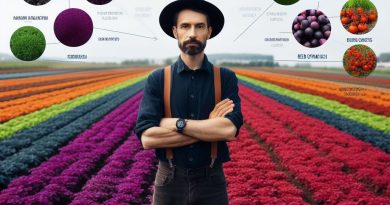Irrigation in Crisis: Climate Change and Water Use
Last Updated on February 11, 2024
Introduction
Let’s Explore Irrigation in Crisis: Climate Change and Water Use
Irrigation is crucial for agriculture, providing water for crop growth and ensuring food production.
Climate change exacerbates water scarcity, threatening irrigation systems and agricultural sustainability.
Thesis statement: This blog post will explore the impact of climate change on irrigation water use and propose solutions.
In agriculture, irrigation plays a vital role, supplying water to crops for growth and productivity.
However, climate change poses increasing challenges, with rising temperatures and altered precipitation patterns leading to water scarcity.
This has profound implications for irrigation systems and agricultural practices, impacting crop yields and food security.
Addressing these challenges requires innovative solutions and adaptive strategies.
By understanding the impact of climate change on water use in irrigation, we can develop sustainable practices to mitigate its effects.
This blog post will delve into the various ways climate change affects irrigation and offer potential solutions to ensure water efficiency and agricultural resilience in the face of evolving environmental conditions.
Climate Change and its Effect on Water Resources
Climate change presents significant challenges to water resources worldwide, profoundly impacting irrigation and agricultural sustainability.
How climate change patterns are altering rainfall distribution
Climate change disrupts traditional rainfall patterns, leading to erratic precipitation distribution across regions
Some areas experience increased rainfall, resulting in floods and soil erosion, while others face prolonged dry spells and drought conditions.
This variability in rainfall distribution complicates water management and irrigation planning, making it challenging for farmers to predict water availability for their crops.
Increased frequency and intensity of droughts
Climate change is associated with an increased frequency and intensity of drought events in many regions.
Prolonged dry spells lead to water scarcity, affecting agricultural productivity and ecosystem health.
Droughts can result in crop failures, reduced yields, and economic losses for farmers.
Moreover, water shortages exacerbate competition for limited water resources among various sectors, including agriculture, industry, and urban areas, further intensifying the impacts of droughts.
The rising temperatures affecting evaporation rates
Elevated temperatures associated with climate change accelerate water evaporation from soil and water bodies.
Increased evaporation rates lead to soil moisture depletion, exacerbating drought conditions and reducing water availability for irrigation.
High temperatures also contribute to the drying of surface water sources, such as rivers and lakes, impacting aquatic ecosystems and freshwater supply for irrigation purposes.
Consequently, farmers must adopt water-saving irrigation practices and implement efficient water management strategies to mitigate the impacts of rising temperatures on water resources.
Impact of melting glaciers on water availability
Melting glaciers, a direct consequence of global warming, significantly affect water availability in regions dependent on glacier-fed rivers and streams.
As glaciers retreat, they release meltwater into rivers, contributing to water supply for irrigation, hydropower generation, and drinking water.
However, the rapid melting of glaciers can lead to short-term increases in water availability followed by long-term decreases as glacier volume diminishes.
This poses challenges for water resource management and requires proactive adaptation strategies to ensure sustainable water supply in glacier-dependent regions.
Emphasize the overall reduction of water resources due to climate change
Climate change leads to an overall reduction in freshwater resources due to a combination of factors, including altered precipitation patterns, increased evaporation, and melting glaciers.
This reduction in water availability poses significant challenges for agricultural irrigation, urban water supply, and ecosystem health.
Sustainable water management practices, including water conservation, efficient irrigation techniques, and integrated water resource management, are essential for mitigating the impacts of climate change on water resources and ensuring water security for future generations.
Collaboration among stakeholders, including governments, communities, and industries, is crucial for developing and implementing effective adaptation measures to address the challenges posed by climate change on water resources.
Read: Heat Stress on Soil: Protecting Our Farms
Water Use in Agriculture
Brief overview of the substantial water demand for agricultural irrigation
- Agriculture accounts for a significant portion of global water consumption.
- Irrigation is essential to meet the high water demand for crop cultivation.
- The volume of water required for irrigation varies depending on crop types and climatic conditions.
- Without irrigation, many agricultural regions would not be able to sustain crop production.
Discuss different irrigation methods commonly used in farming
- Flood Irrigation: Involves flooding the entire field with water, which can lead to waterlogging and wastage.
- Furrow Irrigation: Water is directed into shallow channels or furrows between crop rows.
- Sprinkler Irrigation: Water is sprayed over the crops using sprinklers, mimicking natural rainfall.
- Drip Irrigation: Small amounts of water are directly applied to the root zone of plants, minimizing wastage.
- Center Pivot Irrigation: Uses mechanized systems to rotate sprinklers around a pivot point, covering large areas.
Inefficiencies and wastage associated with traditional irrigation techniques
- Flood and furrow irrigation methods often result in water losses due to evaporation and runoff.
- Sprinkler systems can lose water through wind drift and uneven distribution.
- Traditional methods may lead to overwatering, causing soil erosion and nutrient leaching.
- Inefficient irrigation increases energy consumption and the depletion of groundwater resources.
Importance of sustainable water management in agriculture
- Sustainable water management ensures efficient use of water resources without compromising future availability.
- Adopting modern irrigation techniques reduces water wastage and improves crop productivity.
- Proper scheduling of irrigation can prevent water stress or overhydration for crops.
- Integrating water-saving practices like rainwater harvesting and wastewater reuse promotes sustainability.
- Sustainable water management contributes to climate change mitigation and adaptation in agriculture.
Read: Climate-Smart Farming: Future of US Agriculture

Challenges and Consequences of Water Scarcity in Irrigation
Challenges faced by farmers due to water scarcity
As water scarcity becomes a growing concern in irrigation, farmers face numerous challenges.
The lack of access to sufficient water for irrigation is a major hurdle.
Without adequate water, farmers struggle to meet the water requirements of their crops, resulting in stunted growth and lower productivity.
Reduced crop yields and economic losses
This, in turn, leads to reduced crop yields, resulting in economic losses for farmers.
Smaller crop sizes translate to decreased income and potential loss of livelihoods for agricultural workers.
Moreover, local agricultural economies suffer as productivity declines, affecting both the domestic food supply and export potential.
Potential rise in food prices and impact on food security
The impact of water scarcity extends beyond the farming community.
A potential rise in food prices is a significant concern.
With a decreased supply of crops, demand and prices are expected to increase, leading to inflationary pressure on food prices.
This inflation can disproportionately affect consumers, especially vulnerable populations who struggle with food scarcity and lack of affordability.
Furthermore, water scarcity necessitates an increased reliance on food imports and foreign markets, which can compromise a nation’s food security.
By relying heavily on external sources for food, a country becomes vulnerable to fluctuations in international markets and may face difficulties in maintaining a stable food supply.
Environmental consequences of over-extracting water resources
The consequences of water scarcity also have severe environmental implications.
Over-extracting water resources contributes to the depletion of groundwater reserves.
This can lead to land subsidence, soil degradation, and even the loss of wetlands and ecosystems that depend on these water sources.
Furthermore, the quality of water and soil is negatively affected as a result of reduced water availability.
Changes in water quality and the salinization of soil can have detrimental effects on crop growth and overall ecosystem health.
The loss of biodiversity and habitat destruction further compound the environmental consequences of over-extracting water resources.
Therefore, water scarcity in irrigation poses significant challenges and consequences.
Farmers struggle to access sufficient water, leading to reduced crop yields and economic losses.
The potential rise in food prices affects food security, particularly for vulnerable populations.
Moreover, over-extracting water resources has severe environmental implications, threatening ecosystems and biodiversity.
Urgent action is needed to mitigate these challenges and ensure sustainable water use in irrigation.
Read: Soil Health: Balancing pH and Climate
Potential Solutions for Sustainable Irrigation
Importance of Adopting Climate-Smart Agricultural Practices
Adopting climate-smart agricultural practices is crucial in ensuring sustainable irrigation systems.
Farmers need to adapt to changing climate patterns and develop resilient farming techniques.
One important practice is crop diversification, where farmers grow a variety of crops suitable for different weather conditions.
This reduces the risk of total crop failure due to unpredictable climate events.
Additionally, practicing conservation tillage can help retain moisture in the soil, making irrigation more effective.
This technique involves minimizing soil disturbance during planting to increase water holding capacity.
Furthermore, farmers should prioritize the use of organic fertilizers instead of chemical-based ones, as they facilitate better water retention in the soil.
This reduces the overall demand for irrigation water.
Use of Precision Irrigation Techniques to Optimize Water Use
Precision irrigation techniques play a significant role in conserving water and maximizing its efficiency.
These techniques provide the right amount of water to crops at the right time.
Drones equipped with sensors can be used to monitor crop water needs and deliver targeted irrigation.
This ensures that water is not wasted by watering areas that do not require it.
Soil moisture sensors are another valuable tool for precision irrigation.
They provide real-time data on soil moisture, enabling farmers to irrigate only when necessary, avoiding waterlogging and under-irrigation.
Implementing smart irrigation systems that utilize weather forecast data can also optimize water use.
These systems can automatically adjust irrigation schedules based on upcoming rainfall or temperature fluctuations.
Benefits of Implementing Drip Irrigation and Other Water-Saving Technologies
Drip irrigation is a highly efficient method that delivers water directly to the plants’ root zones.
It minimizes water loss due to evaporation and provides precise control over water application.
By using drip irrigation, farmers can achieve water savings of up to 50% compared to traditional surface irrigation methods.
This not only conserves water but also reduces energy and fertilizer requirements, leading to cost savings.
Moreover, installing rainwater harvesting systems can complement drip irrigation.
These systems collect and store rainwater for later use, reducing reliance on freshwater sources.
Other water-saving technologies, such as sprinkler systems with high distribution uniformity, can also contribute to sustainable irrigation.
These systems evenly distribute water, minimizing waste and maximizing crop productivity.
Role of Sustainable Water Management Policies and Regulations
Sustainable water management policies and regulations are essential to ensure responsible water use in agriculture.
Governments must prioritize the development and enforcement of such policies.
Setting water-use efficiency targets can incentivize farmers to adopt sustainable irrigation practices.
Providing financial support and technical assistance can also encourage farmers to transition to more efficient irrigation systems.
Implementing water pricing mechanisms, where farmers pay for the volume of water they use, can also promote water conservation.
This encourages farmers to adopt efficient irrigation techniques to minimize costs.
Furthermore, governments should invest in water infrastructure development, including reservoirs, canals, and distribution networks.
This helps ensure equitable access to water resources and enhances irrigation efficiency.
Most importantly, sustainable irrigation practices are crucial in mitigating the water crisis exacerbated by climate change.
Adapting climate-smart agricultural practices, utilizing precision irrigation techniques, implementing drip irrigation, and enacting appropriate policies and regulations are among the viable solutions to ensure sustainable water use in agriculture
Embracing these solutions will not only conserve water resources but also contribute to food security and climate resilience.
Read: Climate Change & Pest Pressure on Soil
Case Studies and Success Stories
Examples of regions successfully adapting to water scarcity
- In the arid region of Rajasthan, India, villagers have implemented rainwater harvesting systems to collect and store water for irrigation.
- Australia’s Murray-Darling Basin has implemented water trading systems, allowing farmers to buy and sell water allocations based on their needs.
- The state of California has invested in water-efficient technologies and improved irrigation practices to mitigate the effects of drought.
Discuss innovative irrigation techniques applied in drought-prone areas
- Drip irrigation systems deliver water directly to the roots of plants, minimizing evaporation and improving water efficiency.
- Precision irrigation uses sensors to monitor soil moisture levels, ensuring that water is only applied when necessary.
- Aquaponics combines fish farming with hydroponic plant cultivation, creating a closed-loop system that maximizes water utilization.
Importance of education and knowledge sharing in promoting sustainable irrigation practices
- Farmer-to-farmer knowledge exchange programs can disseminate successful irrigation practices among agricultural communities.
- Training programs and workshops provide farmers with the necessary skills and knowledge to implement water-saving techniques.
- Collaboration between researchers, policymakers, and farmers can foster innovation and the adoption of sustainable irrigation practices.
By showcasing successful case studies and highlighting innovative techniques, it becomes evident that adaptation to water scarcity is achievable.
The examples from Rajasthan, Australia, and California demonstrate that with the right strategies in place, regions can overcome the challenges posed by water scarcity.
Implementing innovative irrigation techniques such as drip irrigation, precision irrigation, and aquaponics can significantly improve water efficiency and mitigate the impact of droughts.
These techniques minimize water wastage and ensure that agricultural activities can continue even in water-stressed areas.
However, it is crucial to recognize that knowledge sharing and education play a vital role in promoting sustainable irrigation practices.
By supporting farmer-to-farmer knowledge exchange and providing training programs, farmers can learn from each other’s experiences and gain the skills needed to implement water-saving techniques effectively.
Moreover, collaboration between researchers, policymakers, and farmers is essential to drive innovation in irrigation practices.
By working together, they can develop and promote sustainable practices that align with local conditions and ensure long-term water availability for irrigation.
In essence, successful case studies and innovative irrigation techniques offer hope for overcoming water scarcity challenges.
Regions like Rajasthan, Australia’s Murray-Darling Basin, and California have successfully adapted by implementing appropriate strategies.
Through education, knowledge sharing, and collaboration, we can collectively promote sustainable irrigation practices and ensure water availability for agricultural activities even in the face of climate change and water scarcity.
Conclusion
Recap the main points discussed in the blog post
- Climate change disrupts rainfall patterns.
- Droughts intensify in frequency and severity.
- Rising temperatures escalate evaporation rates.
- Melting glaciers diminish water sources.
Emphasize the urgency of addressing the irrigation crisis
- Climate change poses existential threats.
- Water scarcity jeopardizes agricultural sustainability.
- Immediate action is imperative for adaptation.
Encourage readers to support sustainable agriculture and water management practices
- Advocate for climate-conscious policies.
- Adopt water-saving irrigation techniques.
- Promote sustainable farming practices.
- Prioritize water conservation efforts.
Confronting the irrigation crisis induced by climate change requires urgent action and collective efforts.
Let’s work together to safeguard our water resources and ensure a sustainable future for agriculture.


